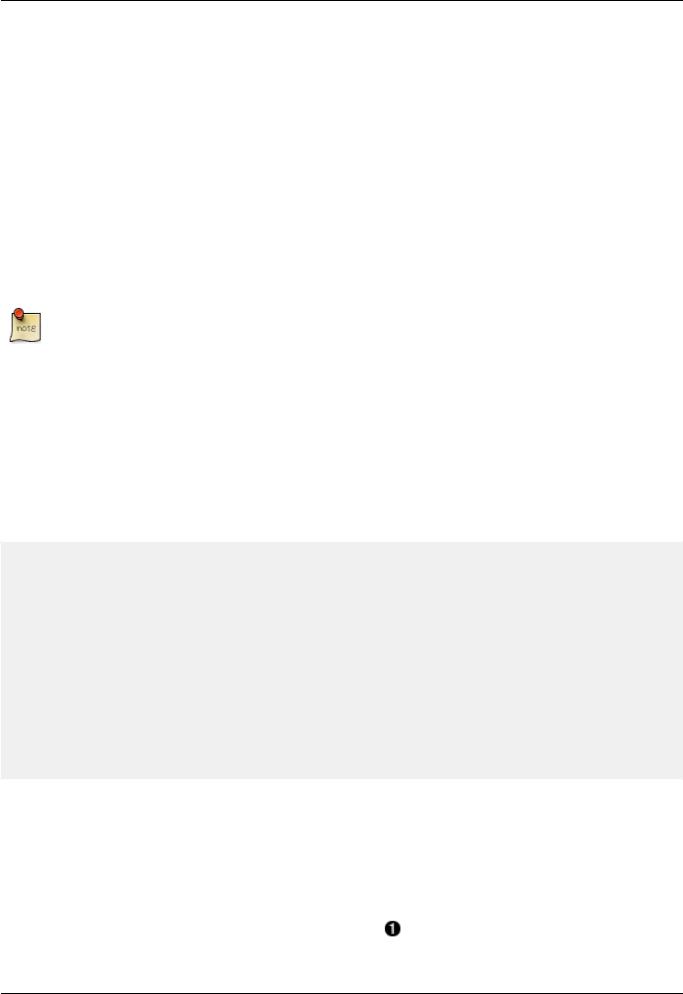
- •AsciiDoc User Guide
- •Table of Contents
- •Introduction
- •Getting Started
- •Installing the AsciiDoc tarball distribution
- •Example AsciiDoc Documents
- •AsciiDoc Document Types
- •article
- •book
- •manpage
- •AsciiDoc Backends
- •docbook
- •xhtml11
- •Stylesheets
- •html4
- •linuxdoc
- •Document Structure
- •Block Elements
- •Header
- •Preamble
- •Sections
- •Special Sections
- •Inline Elements
- •Document Processing
- •Text Formatting
- •Quoted Text
- •Inline Passthroughs
- •Superscripts and Subscripts
- •Line Breaks (HTML/XHTML)
- •Rulers (HTML/XHTML)
- •Tabs
- •Replacements
- •Special Words
- •Titles
- •Two line titles
- •One line titles
- •BlockTitles
- •BlockId Element
- •Paragraphs
- •Default Paragraph
- •Literal Paragraph
- •Admonition Paragraphs
- •Admonition Icons and Captions
- •Delimited Blocks
- •Predefined Delimited Blocks
- •Listing Blocks
- •Literal Blocks
- •SidebarBlocks
- •Comment Blocks
- •Passthrough Blocks
- •Quote Blocks
- •Example Blocks
- •Admonition Blocks
- •Lists
- •Bulleted and Numbered Lists
- •Vertical Labeled Lists
- •Horizontal Labeled Lists
- •Question and Answer Lists
- •Glossary Lists
- •Bibliography Lists
- •List Item Continuation
- •List Block
- •Footnotes
- •Indexes
- •Callouts
- •Implementation Notes
- •Macros
- •Inline Macros
- •URLs
- •Internal Cross References
- •anchor
- •xref
- •Linking to Local Documents
- •Images
- •Block Macros
- •Block Identifier
- •Images
- •Comment Lines
- •System Macros
- •Include Macros
- •Conditional Inclusion Macros
- •eval, sys and sys2 System Macros
- •Template System Macro
- •Macro Definitions
- •Tables
- •Example Tables
- •AsciiDoc Table Block Elements
- •Ruler
- •Row and Data Elements
- •Underline
- •Attribute List
- •Markup Attributes
- •Manpage Documents
- •Document Header
- •The NAME Section
- •The SYNOPSIS Section
- •Configuration Files
- •Configuration File Format
- •Markup Template Sections
- •Special Sections
- •Miscellaneous
- •Titles
- •Tags
- •Attributes Section
- •Special Characters
- •Quoted Text
- •Special Words
- •Replacements
- •Configuration File Names and Locations
- •Document Attributes
- •Attribute Entries
- •Attribute Lists
- •Macro Attribute lists
- •AttributeList Element
- •Attribute References
- •Simple Attributes References
- •Conditional Attribute References
- •Conditional attribute examples
- •System Attribute References
- •Intrinsic Attributes
- •Block Element Definitions
- •Styles
- •Paragraphs
- •Delimited Blocks
- •Lists
- •Tables
- •Filters
- •Filter Search Paths
- •Filter Configuration Files
- •Code Filter
- •Converting DocBook to other file formats
- •a2x Toolchain Wrapper
- •Toolchain Components
- •AsciiDoc DocBook XSL Drivers
- •Generating Plain Text Files
- •XML and Character Sets
- •PDF Fonts
- •Help Commands
- •Customizing Help
- •Tips and Tricks
- •Know Your Editor
- •Vim Commands for Formatting AsciiDoc
- •Text Wrap Paragraphs
- •Format Lists
- •Indent Paragraphs
- •Troubleshooting
- •Gotchas
- •Combining Separate Documents
- •Processing Document Sections Separately
- •Processing Document Chunks
- •Badges in HTML Page Footers
- •Pretty Printing AsciiDoc Output
- •Supporting Minor DocBook DTD Variations
- •Shipping Stand-alone AsciiDoc Source
- •Inserting Blank Space
- •Closing Open Sections
- •Validating Output Files
- •Glossary
- •A. Migration Notes
- •Version 6 to version 7
- •B. Packager Notes
- •C. AsciiDoc Safe Mode
- •E. Installing FOP on Linux
- •F. Installing Java on Windows
- •G. Installing Java on Linux

AsciiDoc User Guide
indexterm:[<primary>,<secondary>,<tertiary>] , ++<primary>,<secondary>,<tertiary>++ ,
This inline macro generates an index term (the <secondary> and <tertiary> attributes are optional). For example indexterm:[Tigers,Big cats] (or, using the alternative syntax ++Tigers,Big cats++. Index terms that have secondary and tertiary entries also generate separate index terms for the secondary and tertiary entries. The index terms appear in the index, not the primary text flow.
indexterm2:[<primary>] , +<primary>+ ,
This inline macro generates an index term that appears in both the index and the primary text flow. The <primary> should not be padded to the left or right with white space characters.
For working examples see the article.txt and book.txt documents in the AsciiDoc ./doc distribution directory.
Note
Index entries only really make sense if you are generating DocBook markup — DocBook conversion programs automatically generate an index at the point an Index section appears in source document.
Callouts
Callouts are a mechanism for annotating verbatim text (source code, computer output and user input for example). Callout markers are placed inside the annotated text while the actual annotations are presented in a callout list after the annotated text. Here's an example:
.MS-DOS directory listing |
|
|
||
..................................................... |
||||
10/17/97 |
9:04 |
<DIR> |
bin |
|
10/16/97 |
14:11 |
<DIR> |
DOS |
<1> |
10/16/97 |
14:40 |
<DIR> |
Program Files |
|
10/16/97 |
14:46 |
<DIR> |
TEMP |
|
10/17/97 |
9:04 |
<DIR> |
tmp |
|
10/16/97 |
14:37 |
<DIR> |
WINNT |
|
10/16/97 |
14:25 |
119 |
AUTOEXEC.BAT |
<2> |
2/13/94 |
6:21 |
54,619 |
COMMAND.COM |
<2> |
10/16/97 |
14:25 |
115 |
CONFIG.SYS |
<2> |
11/16/97 |
17:17 |
61,865,984 |
pagefile.sys |
|
2/13/94 |
6:21 |
9,349 |
WINA20.386 |
<3> |
..................................................... |
||||
<1> This directory holds MS-DOS. <2> System startup code for DOS. <3> Some sort of Windows 3.1 hack.
Which renders:
Example 2. MS-DOS directory listing
10/17/97 |
9:04 |
<DIR> |
bin |
10/16/97 |
14:11 |
<DIR> |
DOS |
10/16/97 |
14:40 |
<DIR> |
Program Files |
10/16/97 |
14:46 |
<DIR> |
TEMP |
10/17/97 |
9:04 |
<DIR> |
tmp |
32

|
|
|
AsciiDoc User Guide |
10/16/97 |
14:37 |
<DIR> |
WINNT |
10/16/97 |
14:25 |
119 |
AUTOEXEC.BAT |
2/13/94 |
6:21 |
54,619 |
COMMAND.COM |
10/16/97 |
14:25 |
115 |
CONFIG.SYS |
11/16/97 |
17:17 |
61,865,984 |
pagefile.sys |
2/13/94 |
6:21 |
9,349 |
WINA20.386 |
This directory holds MS-DOS.
 System startup code for DOS.
System startup code for DOS.
Some sort of Windows 3.1 hack.
Explanation
•The callout marks are whole numbers enclosed in angle brackets that refer to an item index in the following callout list.
•By default callout marks are confined to LiteralParagraphs, LiteralBlocks and ListingBlocks (although this is a configuration file option and can be changed).
•Callout list item numbering is fairly relaxed — list items can start with <n>, n> or > where n is the optional list item number (in the latter case list items starting with a single > character are implicitly numbered starting at one).
•Callout lists should not be nested — start list items hard against the left margin.
•If you want to present a number inside angle brackets you'll need to escape it with a backslash to prevent it being interpreted as a callout mark.
Implementation Notes
Callout marks are generated by the callout inline macro while callout lists are generated using the callout list definition. The callout macro and callout list are special in that they work together. The callout inline macro is not enabled by the normal macros substitutions option, instead it has it's own callouts substitution option.
The following attributes are available during inline callout macro substitution:
{index}
The callout list item index inside the angle brackets.
{coid}
An identifier formatted like CO<listnumber>-<index> that uniquely identifies the callout mark. For example CO2-4 identifies the fourth callout mark in the second set of callout marks.
The {coids} attribute can be used during callout list item substitution — it is a space delimited list of callout IDs that refer to the explanatory list item.
33
